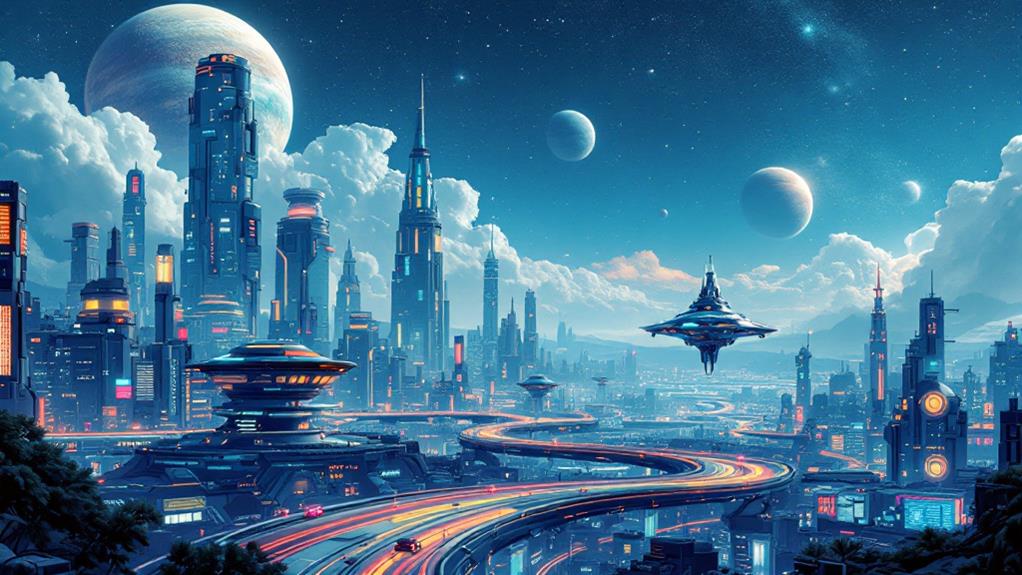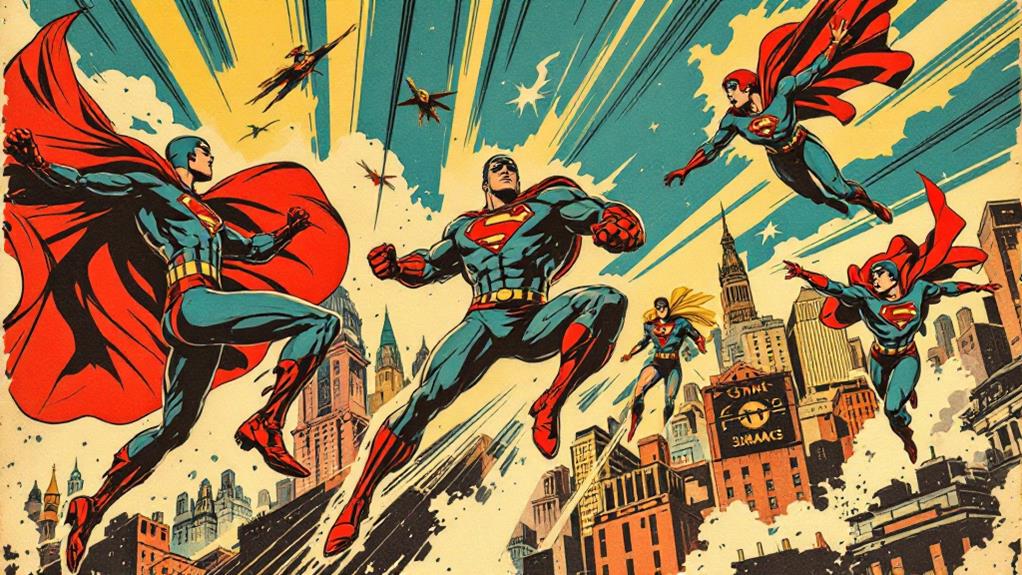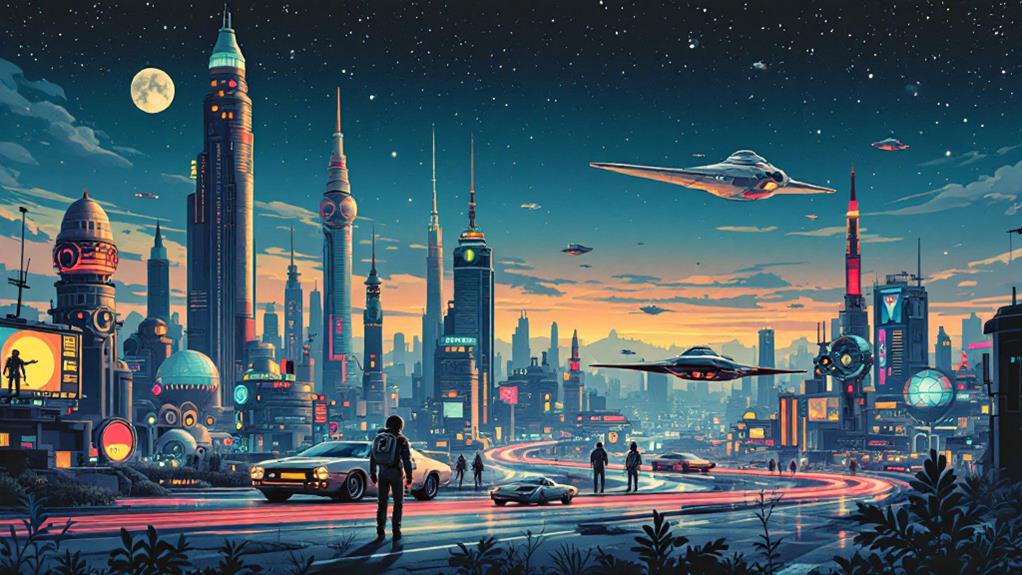How Science Played a Role in the Oldest Marvel Comics
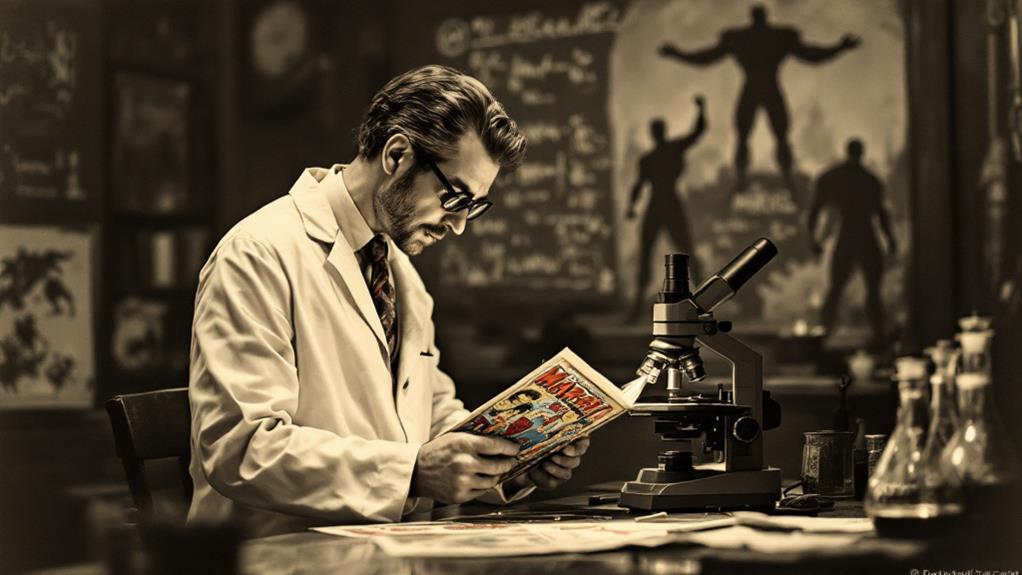
Science played a pivotal role in shaping the earliest Marvel Comics. You'll find iconic superheroes like Spider-Man, Hulk, and the Fantastic Four gaining their powers through radiation exposure. Marvel's writers cleverly tapped into the Atomic Age's fascination with nuclear physics, using scientific concepts as a springboard for fantastic tales. They consulted scientific advisors to guarantee authenticity, setting Marvel apart from competitors. Golden Age comics showcased technological marvels, while science-based villains allowed exploration of complex themes. Space exploration and scientific ethics became prominent storytelling elements. Marvel's approach not only entertained but also inspired generations of future scientists and innovators. The world of scientific wonders in Marvel Comics awaits your discovery.
Radioactive Origins of Superpowers
Three iconic Marvel superheroes owe their extraordinary abilities to radiation exposure. You'll recognize Spider-Man, who gained his powers after being bitten by a radioactive spider. The Hulk emerged when Dr. Bruce Banner was caught in a gamma radiation blast. And the Fantastic Four developed their unique abilities after cosmic radiation bombarded their spacecraft.
These origin stories reflect the fascination and fear surrounding nuclear technology in the 1960s. Marvel's writers tapped into the public's imagination, using radiation as a catalyst for biological alterations that granted superhuman abilities. They cleverly combined scientific concepts with fantasy, creating characters that resonated with readers.
You'll notice that radiation in these comics often acts as a transformative force, modifying DNA and physiology in ways that defy real-world science. While actual radiation exposure is harmful, Marvel's creative license turned it into a source of power and wonder. This approach allowed the comics to delve into themes of responsibility, identity, and the consequences of scientific advancement, all while entertaining readers with fantastical quests and larger-than-life heroes.
Atomic Age Influences
During the 1950s and 1960s, the Atomic Age cast a long shadow over American culture, and Marvel Comics wasn't immune to its influence. You'll find that many of Marvel's most iconic characters from this era were born from the public's fascination with nuclear physics implications and the rapid scientific leaps and bounds of the time.
As you investigate Marvel's early comics, you'll notice how radiation often plays a central role in origin stories. The Fantastic Four gained their powers after exposure to cosmic rays during a space flight. Bruce Banner transformed into the Hulk after being caught in a gamma bomb explosion. Even Spider-Man's abilities came from a radioactive spider bite.
These storylines reflect the era's mix of excitement and anxiety surrounding atomic energy. You'll see how Marvel writers cleverly tapped into these emotions, using scientific concepts as a springboard for fantastic tales. They created relatable characters grappling with the consequences of cutting-edge technology, mirroring society's own struggle to understand and control the awesome power of the atom.
Early Marvel's Scientific Accuracy
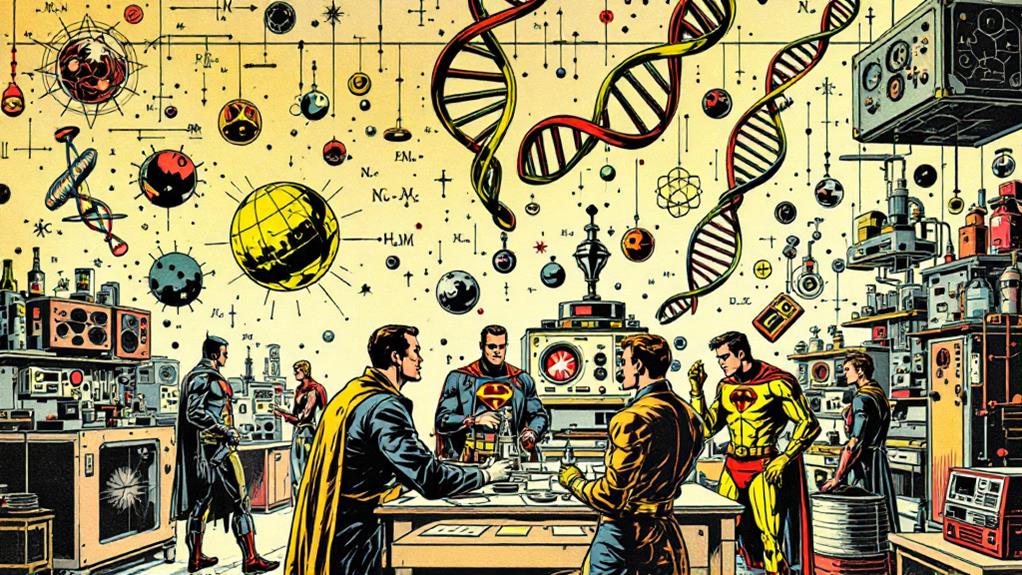
A microscope aimed at early Marvel comics reveals a surprising level of scientific accuracy, despite the fantastical nature of their stories. You'll find that Marvel's creators often consulted scientific advisors to guarantee their narratives had a foundation in reality. This dedication to authenticity set Marvel apart from its competitors and helped forge a deeper connection with readers.
Marvel's approach to scientific accuracy is evident in their grounded character origins. Take Peter Parker's metamorphosis into Spider-Man, for instance. The radioactive spider bite that grants him powers isn't entirely far-fetched, as radiation was known to cause genetic mutations. Similarly, the Fantastic Four's origin story involving cosmic rays aligns with the scientific understanding of space radiation at the time.
Even Iron Man's suit, while highly advanced, was based on plausible technological concepts. The attention to detail extended to the depiction of laboratory equipment and scientific processes in the comics. This blend of science and fantasy not only entertained readers but also sparked their interest in real-world scientific concepts, making Marvel comics an unexpected source of informal science education.
Technology in Golden Age Comics
Golden Age comics were brimming with technological marvels that enthralled readers' imaginations. You'd find heroes wielding gadgets and gizmos that seemed straight out of a futuristic dreamscape. These fictional inventions often pushed the boundaries of what was scientifically possible, yet they were presented with a veneer of plausibility.
Writers and artists would craft pseudoscientific explanations to justify their creations, giving readers a sense that these fantastical technologies might someday become reality. You'd encounter ray guns, invisibility cloaks, and flying cars, all explained with a mix of real scientific concepts and creative speculation.
Marvel Comics, in particular, embraced this trend. Characters like Iron Man showcased state-of-the-art armor and weapons, while Reed Richards of the Fantastic Four employed impossibly advanced machines. Even non-superhero titles featured remarkable inventions, from time machines to shrink rays.
These technological wonders weren't just window dressing; they often drove the plot and defined characters. By blending science fiction with superhero action, Marvel created a unique universe where anything seemed possible, enthralling readers and inspiring generations of future scientists and innovators.
Science-Based Villains and Conflicts
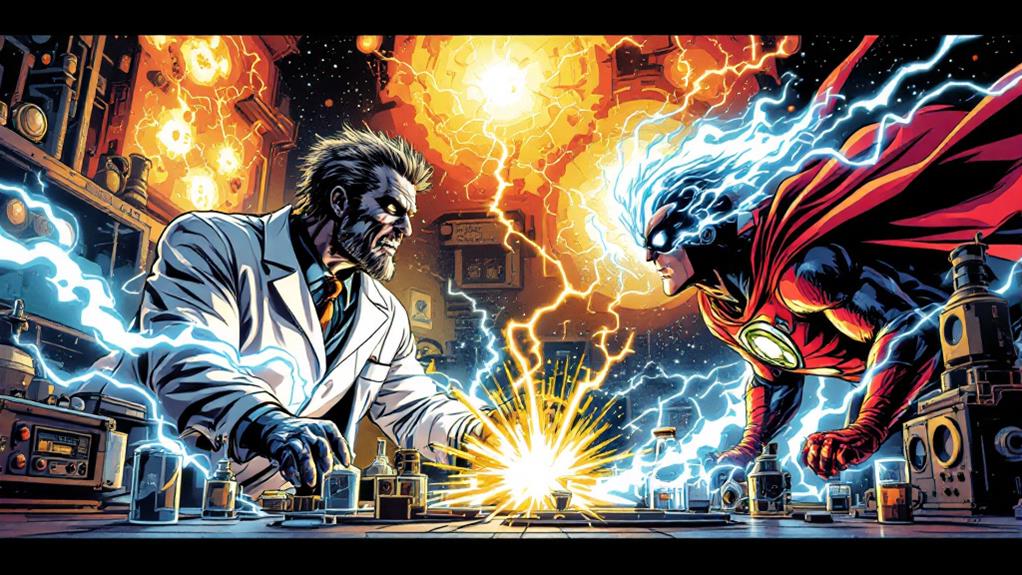
Marvel's science-based villains brought a new dimension to comic book conflicts. You'll find that these antagonists often wielded advanced technologies or possessed extraordinary abilities rooted in scientific concepts. This approach allowed writers to investigate complex themes and societal concerns through the lens of superhero narratives.
- Genetic engineering experiments gone awry
- Mad scientists with world-dominating ambitions
- Radiation-induced mutations and superpowers
- Alien invasions driven by advanced extraterrestrial science
As you immerse yourself in early Marvel comics, you'll notice how science-based conflicts reflected the anxieties of the atomic age. Environmental concerns began to emerge, with villains threatening Earth's ecosystems through their nefarious schemes. These storylines not only entertained but also educated readers about potential risks associated with unchecked scientific progress.
You'll encounter characters like Doctor Octopus, whose mechanical arms represent the double-edged nature of technological advancement. The Green Goblin's enhancement formula showcases the dangers of unethical human experimentation. These villains' origins often serve as cautionary tales, highlighting the potential consequences of pushing scientific boundaries too far. By grounding conflicts in recognizable scientific concepts, Marvel created a more relatable and thought-provoking universe for its readers.
Space Exploration Themes
Space exploration themes rocketed to prominence in Marvel Comics during the Space Race era. You'll find that as public interest in space travel grew, so did the cosmic adventures in Marvel's pages. The Fantastic Four, created in 1961, gained their powers from cosmic rays during a space mission, setting the stage for countless space-based stories.
Marvel's writers investigated the scientific challenges of space travel, often depicting zero gravity challenges and the need for advanced technology. You'll see characters grappling with weightlessness, designing specialized suits, and developing propulsion systems. Deep space habitats became a recurring element, from alien worlds to space stations, showcasing Marvel's imaginative take on potential future colonization.
The Silver Surfer, introduced in 1966, embodied the ultimate space explorer, traversing the cosmos on his board. His stories often plunged into the vastness and mysteries of space, reflecting real-world scientific discoveries and theories. Through these cosmic narratives, Marvel not only entertained but also educated readers about space concepts, fueling imagination and scientific curiosity in generations of comic book fans.
Scientific Ethics in Storytelling
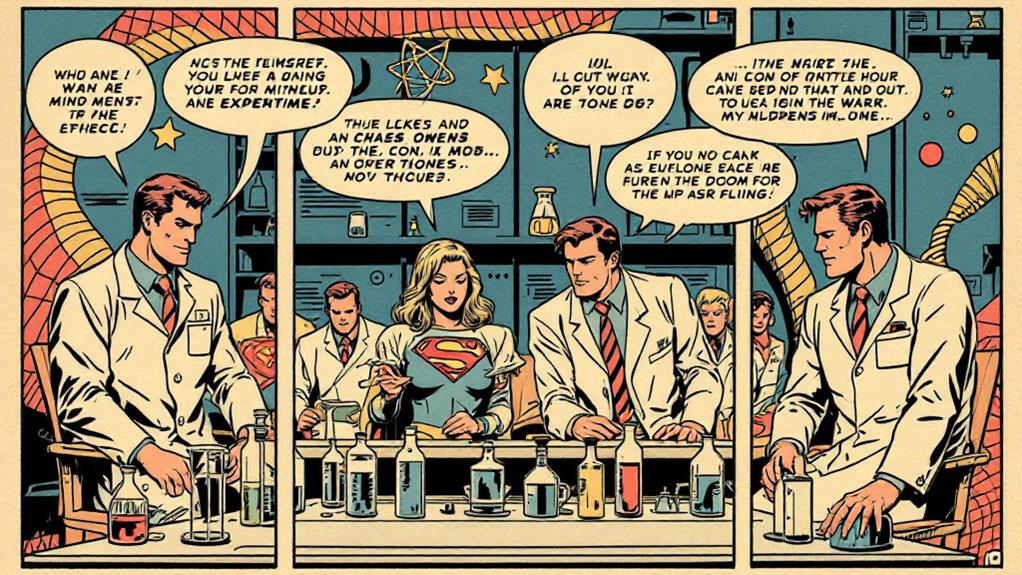
Ethical dilemmas surrounding scientific advancements have long been a cornerstone of Marvel's storytelling. You'll find that early Marvel comics often scrutinized the consequences of unchecked scientific progress, challenging readers to ponder the moral implications of new technologies and discoveries.
Marvel's approach to scientific ethics in storytelling has:
- Raised awareness about potential risks of scientific advancements
- Encouraged critical thinking about the role of science in society
- Examined the responsibility of scientists and their creations
- Looked into the balance between progress and ethical considerations
You'll notice that Marvel consistently weaves scientific credibility into its narratives, grounding fantastical elements in plausible scientific concepts. This approach not only enhances the storytelling but also influences public perception of scientific advancements. By presenting ethical dilemmas in relatable settings, Marvel comics have sparked discussions about the real-world implications of emerging technologies.
As you delve deeper into Marvel's history, you'll see how these ethical explorations have evolved, reflecting changing societal attitudes towards science and technology. The comics continue to challenge readers to ponder the complex interplay between scientific progress and moral responsibility.
